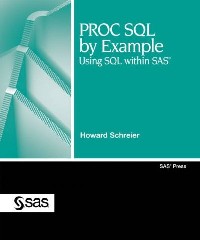简介
Summary:
Publisher Summary 1
In PROC SQL by Example: Using SQL within SAS, author Howard Schreier illustrates the use of PROC SQL in the context of the SAS DATA step and other SAS procedures (such as SORT, FREQ, MEANS, SUMMARY, APPEND, DATASETS, and TRANSPOSE) whose functionality overlaps and complements that of SQL. Using a side-by-side approach, this concise reference guide includes many extensively explained examples showing equivalent DATA step and SQL code, enabling SAS users to take advantage of existing SAS skills and knowledge while learning about SQL. Discussions cover the differences between SQL and the DATA step as well as situations where SQL and the DATA step are used together to benefit from the strengths of each. Topics addressed include working with joins and merges; using subqueries; understanding set operators; using the Macro Facility with PROC SQL; maintaining tables; working with views; using PROC SQL as a report generator; and more. This text is ideal for SAS programmers seeking to add PROC SQL to their SAS toolkits as well as SQL programmers striving to better integrate the SAS DATA step and SQL. SAS Products and Releases: Base SAS: 9.2 Operating Systems: All
目录
Table Of Contents:
Acknowledgments vii
Introduction 1(10)
More about SQL 2(3)
More about This Book 5(6)
Basic Building Blocks 11(26)
The Simplest SELECT Statement 13(2)
A More Selective SELECT 15(1)
Storing Results 16(1)
Column Subsets 17(2)
New Columns 19(1)
Aggregation 20(6)
Conditionality 26(2)
Filtering 28(4)
Reordering Rows 32(1)
Elimination of Duplicates 33(2)
Summary 35(2)
More Building Blocks 37(16)
Combining Summary Statistics with Original Detail 38(5)
Summary Statistics Based on Distinct Values 43(3)
Preprocessing the Source with Inline Views 46(5)
Summary 51(2)
Joins 53(28)
Avoiding Ambiguity in Column References 54(2)
The Simplest Merges and Joins 56(3)
Matching with Nonrepeating Keys 59(9)
Matching with Repeating Keys 68(7)
More about Joins and Merges 75(2)
More about Joins 77(2)
Summary 79(2)
Subqueries 81(16)
Contexts That Expect Subqueries 84(9)
General Usage of Subqueries 93(2)
Summary 95(2)
Set Operators 97(34)
The Contrast between Joins and Set Operators 98(1)
Set Operators: Preview 99(5)
Concatenation and Interleaving with Outer Union 104(6)
Data Type Compatibility 110(1)
Overview: Union, Intersect, and Except 111(2)
Union 113(10)
Intersect 123(3)
Except 126(3)
Summary 129(2)
Global Statements, Options, and Session Management 131(10)
Global Statements 133(3)
Proc Sql Options 136(3)
Summary 139(2)
Using the Macro Facility with Proc Sql 141(20)
Generating Proc Sql Code 141(3)
Populating Macro Variables 144(16)
Summary 160(1)
Table Maintenance and Alternate Strategies 161(44)
Environment for Examples 164(2)
Distinguishing Persistence from Replacement 166(2)
Life Cycle of a Table 168(5)
Data Maintenance 173(10)
Metadata Maintenance 183(2)
Changing Structure 185(2)
Changing Features 187(16)
Summary 203(2)
Views 205(14)
Defining Views 207(1)
Using Views 207(3)
Inspecting Views 210(2)
Changing a Table via a View 212(2)
Managing Library References 214(4)
Summary 218(1)
Proc Sql as a Report Generator 219(14)
Simple Reports 220(2)
Complex Reports 222(3)
Reports with Long Character Strings 225(4)
Proc Sql and the Output Delivery System 229(2)
Summary 231(2)
Mixed Solutions 233(16)
Example: Schedule Matrix 234(4)
Example: Identifying Spikes in a Series 238(4)
Example: Using Proc Transpose to Normalize 242(6)
Summary 248(1)
Performance Tuning 249(6)
Resource Example: The Effect of an Index 250(1)
Code Example: The Advantage of Equijoins 251(3)
Summary 254(1)
Documentation Roadmap 255(16)
Where to Start? 256(5)
Following Cross References 261(3)
The Three Expressions Revisited 264(2)
Could It Be More Logical? 266(2)
Summary 268(3)
Appendix A Sashelp.Class Data Set 271(2)
Appendix B Online Resources 273(2)
Index 275
Acknowledgments vii
Introduction 1(10)
More about SQL 2(3)
More about This Book 5(6)
Basic Building Blocks 11(26)
The Simplest SELECT Statement 13(2)
A More Selective SELECT 15(1)
Storing Results 16(1)
Column Subsets 17(2)
New Columns 19(1)
Aggregation 20(6)
Conditionality 26(2)
Filtering 28(4)
Reordering Rows 32(1)
Elimination of Duplicates 33(2)
Summary 35(2)
More Building Blocks 37(16)
Combining Summary Statistics with Original Detail 38(5)
Summary Statistics Based on Distinct Values 43(3)
Preprocessing the Source with Inline Views 46(5)
Summary 51(2)
Joins 53(28)
Avoiding Ambiguity in Column References 54(2)
The Simplest Merges and Joins 56(3)
Matching with Nonrepeating Keys 59(9)
Matching with Repeating Keys 68(7)
More about Joins and Merges 75(2)
More about Joins 77(2)
Summary 79(2)
Subqueries 81(16)
Contexts That Expect Subqueries 84(9)
General Usage of Subqueries 93(2)
Summary 95(2)
Set Operators 97(34)
The Contrast between Joins and Set Operators 98(1)
Set Operators: Preview 99(5)
Concatenation and Interleaving with Outer Union 104(6)
Data Type Compatibility 110(1)
Overview: Union, Intersect, and Except 111(2)
Union 113(10)
Intersect 123(3)
Except 126(3)
Summary 129(2)
Global Statements, Options, and Session Management 131(10)
Global Statements 133(3)
Proc Sql Options 136(3)
Summary 139(2)
Using the Macro Facility with Proc Sql 141(20)
Generating Proc Sql Code 141(3)
Populating Macro Variables 144(16)
Summary 160(1)
Table Maintenance and Alternate Strategies 161(44)
Environment for Examples 164(2)
Distinguishing Persistence from Replacement 166(2)
Life Cycle of a Table 168(5)
Data Maintenance 173(10)
Metadata Maintenance 183(2)
Changing Structure 185(2)
Changing Features 187(16)
Summary 203(2)
Views 205(14)
Defining Views 207(1)
Using Views 207(3)
Inspecting Views 210(2)
Changing a Table via a View 212(2)
Managing Library References 214(4)
Summary 218(1)
Proc Sql as a Report Generator 219(14)
Simple Reports 220(2)
Complex Reports 222(3)
Reports with Long Character Strings 225(4)
Proc Sql and the Output Delivery System 229(2)
Summary 231(2)
Mixed Solutions 233(16)
Example: Schedule Matrix 234(4)
Example: Identifying Spikes in a Series 238(4)
Example: Using Proc Transpose to Normalize 242(6)
Summary 248(1)
Performance Tuning 249(6)
Resource Example: The Effect of an Index 250(1)
Code Example: The Advantage of Equijoins 251(3)
Summary 254(1)
Documentation Roadmap 255(16)
Where to Start? 256(5)
Following Cross References 261(3)
The Three Expressions Revisited 264(2)
Could It Be More Logical? 266(2)
Summary 268(3)
Appendix A Sashelp.Class Data Set 271(2)
Appendix B Online Resources 273(2)
Index 275
- 名称
- 类型
- 大小
光盘服务联系方式: 020-38250260 客服QQ:4006604884
云图客服:
用户发送的提问,这种方式就需要有位在线客服来回答用户的问题,这种 就属于对话式的,问题是这种提问是否需要用户登录才能提问
Video Player
×
Audio Player
×
pdf Player
×



